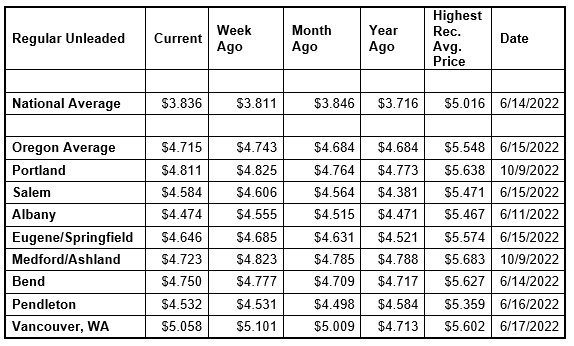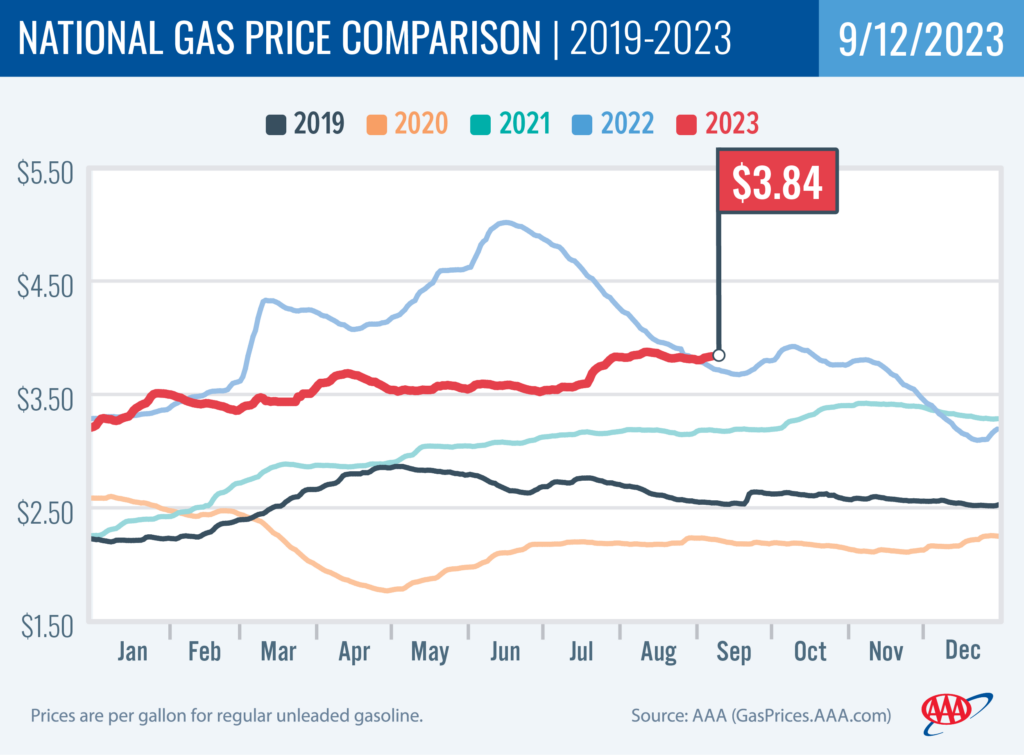National Average Ticks Up after Refinery Issues in the Midwest
PORTLAND, Ore., – Gas prices have surged in some Midwestern states due to refinery issues and that has put some upward pressure on the national average for regular. Here in Oregon, gas prices are edging lower. The switch to winter-blend fuel later this week should put downward pressure on pump prices. However, higher crude oil prices could limit declines at the pumps. For the week, the national average rises three cents to $3.84. The Oregon average ticks down three cents to $4.72.

“The national average had been ticking down since late August but then started to edge up again late last week after some refinery issues in the Midwest caused prices to spike in several states. Meanwhile, the Oregon average has been inching down since late August,” says Marie Dodds, public affairs director for AAA Oregon/Idaho.
September 15 is when most states can switch to winter-blend fuel, which is cheaper to make than summer-blend fuel. Gas prices normally decline this time of year when the transition to winter-blend fuel begins and demand for gasoline declines. Summer-blend fuel helps reduce emissions from gasoline during the warm summer months. More info on summer- and winter-blend gasoline can be found at the EPA website.
“Gas prices should move lower later this month, if crude oil prices don’t surge and assuming no additional refinery issues and no hurricanes that impact oil drilling and refining,” adds Dodds. “However, pump prices may climb a bit more before starting the traditional autumn decline.”
A major storm can disrupt production, especially in the Gulf Coast region where more than 47% of total U.S. petroleum refining capacity is located.
Crude oil prices have rallied again, in response to the announcement from Saudi Arabia that it would extend its oil production cuts through the rest of this year. West Texas Intermediate climbed above $87 per barrel last week, the highest price since last November.
Crude oil is trading around $89 today compared to $87 a week ago and $88 a year ago. In August, West Texas Intermediate ranged between about $77 and $85 per barrel. In July, West Texas Intermediate ranged between about $69 and $82 per barrel. In June, WTI ranged between about $67 and $73 per barrel. In May, WTI ranged between about $63 and $77 per barrel. In April, WTI ranged between about $73 and $83. In March, WTI ranged between about $64 and $81 per barrel. In February, WTI ranged between about $73 and $80 per barrel. In January, WTI ranged between about $73 and $82 bbl. Crude reached recent highs of $123.70 on March 8, 2022, shortly after the Russian invasion of Ukraine, and $122.11 per barrel on June 8, 2022. The all-time high for WTI crude oil is $147.27 in July 2008.
Crude oil is the main ingredient in gasoline and diesel, so pump prices are impacted by crude prices on the global markets. On average, about 50% of what we pay for in a gallon of gasoline is for the price of crude oil, 25% is refining, 11% distribution and marketing, and 14% are taxes, according to the U.S. Energy Information Administration.
Demand for gasoline rose from 9.07 to 9.32 million b/d for the week ending September 1, according to the U.S. Energy Information Administration (EIA). This compares to 8.73 million b/d a year ago. Meanwhile, total domestic gasoline stocks dropped from 217.4 to 214.7 million bbl. Rising oil prices, higher gas demand, and tighter supply may push pump prices higher in the coming days.
Quick stats
Oregon is one of 21 states and the District of Columbia with lower prices now than a week ago. Iowa (+38 cents) and Minnesota (+37 cents) have the largest weekly jumps and are in the parts of the Midwest that were impacted by refinery issues. Ohio (-10 cents) has the biggest weekly decrease.
California ($5.46) has the most expensive gas in the nation for the seventh week in a row. Washington ($5.06) is second. These are the only two states with averages at or above $5 a gallon. Hawaii ($4.80) is third, Oregon ($4.72) is fourth, Nevada ($4.68) is fifth, Alaska ($4.60) is sixth, Arizona ($4.39) is seventh, Utah ($4.26) is eighth, Montana ($4.18) is ninth, Idaho ($4.16) is 10th, North Dakota ($4.03) is 11th, and Colorado ($4.00) is 12th. These are the 12 states with averages at or above $4 a gallon, up from 11 states a week ago. This week 38 states and the District of Columbia have averages in the $3-range. No state has an average in the $2 range this week.
The cheapest gas in the nation is in Mississippi ($3.27) and Louisiana ($3.36). For the 139th week in a row, no state has an average below $2 a gallon.
The difference between the most expensive and least expensive states is $2.20 this week, compared to $2.04 a week ago.
Oregon is one of 24 states with higher prices now than a month ago. The national average is one cent more and the Oregon average is three cents more than a month ago. Arizona (+37 cents) has the largest monthly jump. Michigan (-28 cents) has the largest monthly drop.
Oregon is one of 35 states and the District of Columbia with higher prices now than a year ago. The national average is 12 cents more and the Oregon average is three cents more than a year ago. Iowa (+55 cents) has the largest yearly increase. Hawaii (-49 cents) has the largest year-over-year drop.
West Coast
The West Coast region continues to have the most expensive pump prices in the nation with all seven states in the top 10. It’s typical for the West Coast to have six or seven states in the top 10 as this region tends to consistently have fairly tight supplies, consuming about as much gasoline as is produced. In addition, this region is located relatively far from parts of the country where oil drilling, production and refining occurs, so transportation costs are higher. And environmental programs in this region add to the cost of production, storage and distribution.
| Rank | Region | Price on 9/12/23 |
| 1 | California | $5.46 |
| 2 | Washington | $5.06 |
| 3 | Hawaii | $4.80 |
| 4 | Oregon | $4.72 |
| 5 | Nevada | $4.68 |
| 6 | Alaska | $4.60 |
| 7 | Arizona | $4.39 |
| 8 | Utah | $4.26 |
| 9 | Montana | $4.18 |
| 10 | Idaho | $4.16 |
As mentioned above, California has the most expensive gas in the country. Washington, Hawaii, Oregon, Nevada, Alaska, and Arizona round out the top seven. Oregon is fourth for the 14th week in a row.
Four states in the region are seeing weekly increases: Nevada (+15 cents) and California (+14 cents), Arizona (+6 cents), and Hawaii (+1 cent). The other three states are seeing small weekly declines: Washington (-3 cents), Oregon (-3 cents), and Alaska (-1 cent).
The refinery utilization rate on the West Coast rose from 86.0% to 90.2% for the week ending September 1. This rate has ranged between about 73% to 96% in the last year. The latest national refinery utilization rate slipped from 93.3% to 93.1%.
According to EIA’s latest weekly report, total gas stocks in the region decreased from 26.98 million bbl. to 26.30 million bbl.
A higher refinery utilization rate can put downward pressure on pump prices, while a decrease in gasoline stocks can put upward pressure on pump prices.
Oil market dynamics
The price of WTI increased last week on news that Saudi Arabia plans to continue its voluntary 1 million b/d production cut through the end of the year. Tight supply could boost oil prices if demand remains robust. Additionally, the EIA reported that total domestic commercial crude inventories decreased significantly from 422.9 to 416.6 million bbl.
At the close of Friday’s formal trading session, WTI added 64 cents to settle at $87.51. At the close of Monday’s formal trading session, WTI slipped 22 cents to settle at $87.29. Today crude is trading around $89 compared to $87 a week ago. Crude prices are about $1 more than a year ago.
Drivers can find current gas prices along their route with the free AAA Mobile app for iPhone, iPad and Android. The app can also be used to map a route, find discounts, book a hotel and access AAA roadside assistance. Learn more at AAA.com/mobile.

Diesel
For the week, the national average rises four cents to $4.49 a gallon. The record high is $5.816 set on June 19, 2022. The Oregon average climbs six cents to $5.20. The record high is $6.47 set on July 3, 2022. A year ago the national average for diesel was $5.01 and the Oregon average was $5.56.
Find current fuel prices at GasPrices.AAA.com.
AAA news releases, high resolution images, broadcast-quality video, fact sheets and podcasts are available on the AAA NewsRoom at NewsRoom.AAA.com.
Find local news releases at https://oregon.aaa.com/community/media/media-contacts.html
Fuel prices are updated daily at AAA’s Daily Fuel Gauge at AAA Gas Prices. For more info go www.AAA.com. AAA Oregon/Idaho provides more than 890,000 members with travel, insurance, financial and automotive-related services, and is an affiliate of AAA National, serving more than 63 million motorists in North America.

